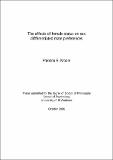Files in this item
The effects of female status on sex differentiated mate preferences
Item metadata
| dc.contributor.advisor | Byrne, Richard W. | |
| dc.contributor.advisor | Perrett, David | |
| dc.contributor.advisor | Brown, Gillian R. | |
| dc.contributor.author | Moore, Fhionna R. | |
| dc.coverage.spatial | 271 p. | en |
| dc.date.accessioned | 2007-05-31T08:11:14Z | |
| dc.date.available | 2007-05-31T08:11:14Z | |
| dc.date.issued | 2007 | |
| dc.identifier.uri | https://hdl.handle.net/10023/332 | |
| dc.description.abstract | Mate preferences provide an opportunity to explore the validity of evolutionary and social role origin theories of sex differences in human behaviour. In evolutionary models, preferences are sex-specific adaptive responses to constraints to reproductive success. In social role models, sex differences arise from the allocation of men and women to different gender roles. I explored the effects of the status of women on preferences to assess the validity of the origin theories. I developed an adequate measure of female status (i.e. resource control), and explored its effects on female preferences in an online survey (Chapter 3), a mail-shot survey (Chapter 4), and a sample of non-industrial societies (Chapter 5). Results implicated a role of constraints on women in the expression of female-typical preferences. In an experimental manipulation of female perceptions of their status, results enabled greater confidence in the attribution of causal direction to relationships (Chapter 6). In Chapter 7, I explored the conditions under which the relationships of interest occurred. In Chapter 8, to further explore the origin models I investigated the effects of resource control on the magnitudes of sex differences in preferences. In Chapter 9, I explored relationships between a characteristic more closely related to the male gender role (i.e. apparent intelligence) and femininity in female faces. Women who were considered to look more intelligent were perceived as less feminine. In Chapter 10, I investigated the effects of reproductive strategy on mate preferences. Results were consistent with evolutionary models of behaviour. I argue that “status” is a multidimensional construct, and that its effects on mate preferences are complex, that while results were generally more consistent with an evolutionary than the biosocial model, integration of models would provide greater insight into human mate preferences. | en |
| dc.format.extent | 1075555 bytes | |
| dc.format.mimetype | application/pdf | |
| dc.language.iso | en | en |
| dc.publisher | University of St Andrews | |
| dc.rights | Creative Commons Attribution-NonCommercial-NoDerivs 3.0 Unported | |
| dc.rights.uri | http://creativecommons.org/licenses/by-nc-nd/3.0/ | |
| dc.subject.lcc | BF692.3M7 | |
| dc.subject.lcsh | Mate selection--Sex differences | en |
| dc.subject.lcsh | Human behavior--Sex differences | en |
| dc.subject.lcsh | Interpersonal attraction | en |
| dc.title | The effects of female status on sex differentiated mate preferences | en |
| dc.type | Thesis | en |
| dc.type.qualificationlevel | Doctoral | en |
| dc.type.qualificationname | PhD Doctor of Philosophy | en |
| dc.publisher.institution | The University of St Andrews | en |
This item appears in the following Collection(s)
Except where otherwise noted within the work, this item's licence for re-use is described as Creative Commons Attribution-NonCommercial-NoDerivs 3.0 Unported
Items in the St Andrews Research Repository are protected by copyright, with all rights reserved, unless otherwise indicated.


